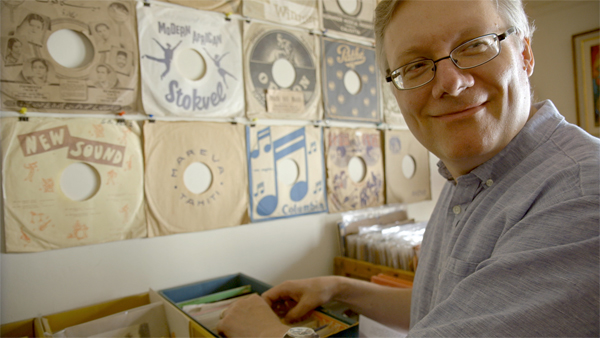The subject of this affectionate documentary is the industrial musical, which super-fan Steve Young covets as a secret universe most of us were never supposed to know. Scouring the bins of record shops and private collections, he vacuums up these relics of the 1960s, ’70s, and ’80s, a period when large corporations would stage elaborate, Broadway-style spectaculars intended to inspire employees, especially salesmen. Young and director Dava Whisenant bring this strange yet charming world to life by recounting its history through those who knew it best.
A comedy writer for The Late Show with David Letterman, Young got his first taste of this unusual genre while looking for unintentionally amusing records to feature in an ongoing segment. By his own admission, he has done this work for so long that his “comedy receptors” have gotten burned out, and so it’s rare that something makes him laugh out loud. Yet something about this music piques his fancy, as we can tell by the animated notes that come out of his appliances as he listens. That kind of flourish, incidentally, is about as subtle as the film gets.
As he starts collecting more of these albums, it turns out that he isn’t alone in his fascination, and he becomes friends with other aficionados. In one of the most charming scenes, he and another collector sing along together to a few of these strange songs, which are part-Broadway bombast, part-advertising jingle. Yet Young takes the hobby a step further and starts looking up the actors and composers on the record jackets, in hopes of piecing together a fuller picture of the world these productions existed in.
Not being much of a Broadway buff, he initially misses out on the fact that many of the shows’ creators included the likes of Sheldon Harnick and Jerry Bock, who would go on to write Fiddler on the Roof. Others who cut their teeth in what they colloquially referred to as “industrials” were actresses Chita Rivera and the late Florence Henderson and future director and choreographer Susan Stroman. They describe how the shows were easily the best paying gigs of the time that could also be valuable proving grounds, even if they ultimately were corporate propaganda.
The creative possibilities of industrials are evident in the photographs and archived footage of various shows, including Young’s personal favorite, The Bathrooms Are Coming, staged by the plumbing supply company National Standard in 1969. While the lyrics are almost shockingly earnest, there are catchy melodies, as well as some inventive staging that we get to see through an old 16mm film recording. Not surprisingly, the industrials’ heyday coincided with a period in which most Americans expected to spend their entire lives at a single company, and so as seismic shifts began to alter the nation’s economy, they affected the shows’ popularity.
Incidentally, Young hits the mother lode when he gets his hands on that reel of The Bathrooms Are Coming, as it leads him to actors who appeared in it and its composer, Sid Siegel, with whom he develops a touching friendship. Siegel seriously discusses the challenges of incorporating products into songs in such a way that was humorous and, dare they say it, sexy. While some industrials recycled radio hits of the time with corporate-friendly lyrics, both Young and the film seem to regard those who wrote original music as a rarer breed. Indeed, Young observes that had The Bathrooms Are Coming’s songs been about something besides bathroom fixtures, Siegel might have had great mainstream success.
Not coincidentally, the film’s depiction of the genre’s decline coincides with the impending end of The Late Show, which makes the latter section of the film extra bittersweet. Luckily, Young has never been so much about looking back on the past as taking advantage of what’s right in front of him. As screen presences go, he might be a little charisma-challenged, but there is something enviable about his ability to exhibit childlike wonder, and he ultimately reminds us of the importance of not only embracing our own eccentricities but following them wherever they may lead.

















Leave A Comment